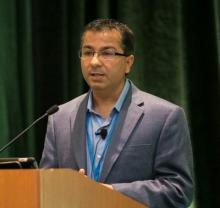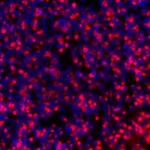
Kapil Bharti, Ph.D.
Senior Investigator
Ocular and Stem Cell Translational Research Section
NEI
Scientific Director
NEI
Research Topics
The goal of the Unit on Ocular Stem Cells and Translational Research (OSCTR) is to perform translational research on degenerative eye diseases using induced pluripotent stem (iPS) cell technology. We are using this technology to develop in vitro disease models to study patient-specific disease processes, to set up high throughput drug screens, and to develop cell-based therapy for retinal degenerative diseases.Our translational goals are focused on the retinal pigment epithelium (RPE), a monolayer of highly polarized cells located in the back of the eye, whose apical processes inter-digitate with photoreceptor outer segments. RPE performs several functions that are absolutely critical for the health and integrity of photoreceptors. Some of these functions include regulating nutrient and metabolite flow, maintaining ionic homeostasis in the sub-retinal space, regenerating visual pigment, and phagocytizing shed photoreceptor outer segments. Dysfunctions in the RPE are thought to be the initiating events leading to degenerative eye diseases. Therefore, a better understanding of the disease initiating pathways in RPE will provide a basis for therapeutic interventions. In collaboration with the NEI clinic, we are obtaining skin biopsies from patients with clinically diagnosed degenerative eye diseases. These biopsies are being used to derive iPS cells. RPE cells differentiated from such iPS cells are used to study events that have led to disease initiation and progression. In collaboration with NCATS, we have combined the patient-specific iPSC approach with high throughput screening assays performed in 384-well plates to identify novel compounds that could act as potential therapeutic agents. In collaboration with new NIH Center for Regenerative Medicine we are developing iPSC-derived RPE tissue for cell-based therapy. We have modified the existing stem cell to RPE differentiation protocols to make them more compliant with current Good Manufacturing Practices (cGMP-work). Our work uses the most cutting-edge technologies in the field and aims to translate these technologies to a clinical use.
Biography
Dr. Bharti holds a bachelor's degree in biophysics from the Panjab University in Chandigarh, India, where he graduated with highest honors. This was followed by a master degree in biotechnology at the Maharaja Sayaji Rao University in Baroda, India and a diploma in molecular cell biology at the Johann Wolfgang Goethe University at Frankfurt in Germany. Supported by an international Ph.D. student fellowship, he obtained his Ph.D. from the same institution, graduating summa cum laude. His Ph.D. work involved basic biology in the areas of heat stress, cellular chaperones, and epigenetics. From Germany, Dr. Bharti came to the National Institute of Neurological Disorders and Stroke to work with Dr. Heinz Arnheiter as a postdoctoral fellow. While there, he published numerous papers in the areas of transcription factor regulation, pigment cell biology, and the developmental biology of the eye. It is perhaps this combination of diverse backgrounds that led him to develop an interest in the emerging field of stem cell biology, particularly of the retinal pigment epithelium, as he moved into the role of staff scientist. Dr. Bharti has authored numerous publications and has won several awards, including, most recently, being a finalist in the prestigious trans-NIH Earl Stadtman Symposium.
Selected Publications
- Sharma R, Khristov V, Rising A, Jha BS, Dejene R, Hotaling N, Li Y, Stoddard J, Stankewicz C, Wan Q, Zhang C, Campos MM, Miyagishima KJ, McGaughey D, Villasmil R, Mattapallil M, Stanzel B, Qian H, Wong W, Chase L, Charles S, McGill T, Miller S, Maminishkis A, Amaral J, Bharti K. Clinical-grade stem cell-derived retinal pigment epithelium patch rescues retinal degeneration in rodents and pigs. Sci Transl Med. 2019;11(475).
- Ortolan D, Sharma R, Volkov A, Maminishkis A, Hotaling NA, Huryn LA, Cukras C, Di Marco S, Bisti S, Bharti K. Single-cell-resolution map of human retinal pigment epithelium helps discover subpopulations with differential disease sensitivity. Proc Natl Acad Sci U S A. 2022;119(19):e2117553119.
- Song MJ, Quinn R, Nguyen E, Hampton C, Sharma R, Park TS, Koster C, Voss T, Tristan C, Weber C, Singh A, Dejene R, Bose D, Chen YC, Derr P, Derr K, Michael S, Barone F, Chen G, Boehm M, Maminishkis A, Singec I, Ferrer M, Bharti K. Bioprinted 3D outer retina barrier uncovers RPE-dependent choroidal phenotype in advanced macular degeneration. Nat Methods. 2023;20(1):149-161.
- Sharma R, George A, Nimmagadda M, Ortolan D, Karla BS, Qureshy Z, Bose D, Dejene R, Liang G, Wan Q, Chang J, Jha BS, Memon O, Miyagishima KJ, Rising A, Lal M, Hanson E, King R, Campos MM, Ferrer M, Amaral J, McGaughey D, Bharti K. Epithelial phenotype restoring drugs suppress macular degeneration phenotypes in an iPSC model. Nat Commun. 2021;12(1):7293.
- Farnoodian M, Bose D, Khristov V, Susaimanickam PJ, Maddileti S, Mariappan I, Abu-Asab M, Campos M, Villasmil R, Wan Q, Maminishkis A, McGaughey D, Barone F, Gundry RL, Riordon DR, Boheler KR, Sharma R, Bharti K. Cell-autonomous lipid-handling defects in Stargardt iPSC-derived retinal pigment epithelium cells. Stem Cell Reports. 2022;17(11):2438-2450.
Related Scientific Focus Areas
This page was last updated on Friday, August 1, 2025




